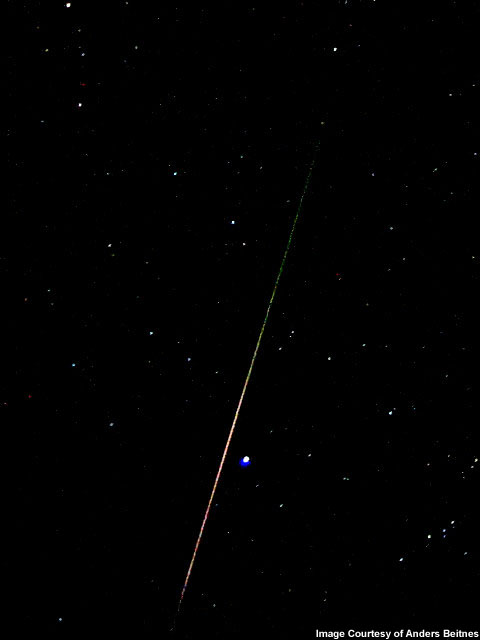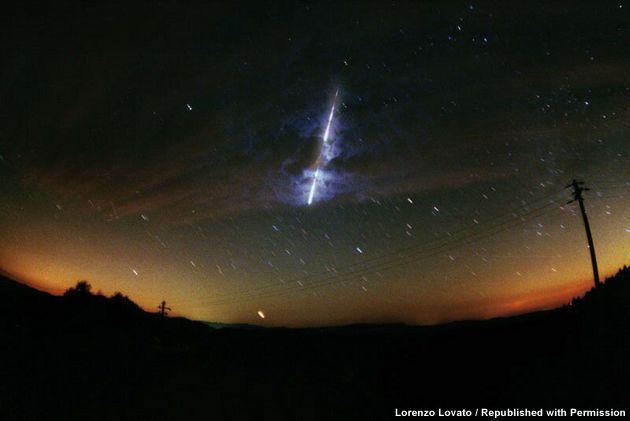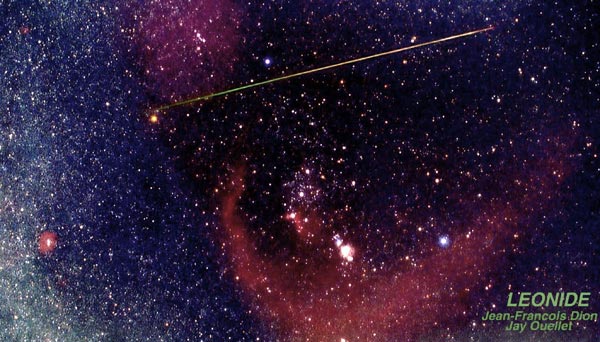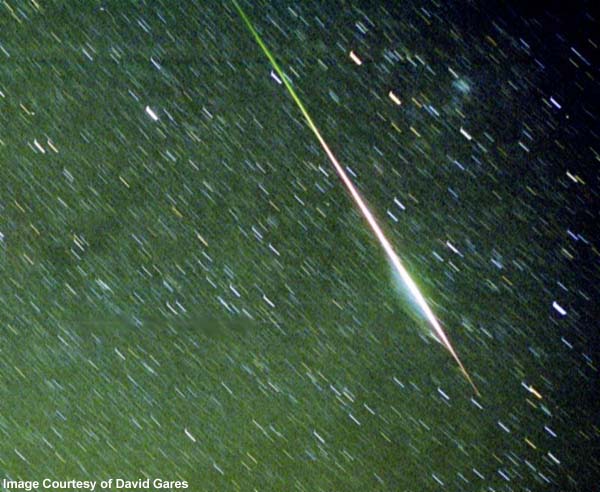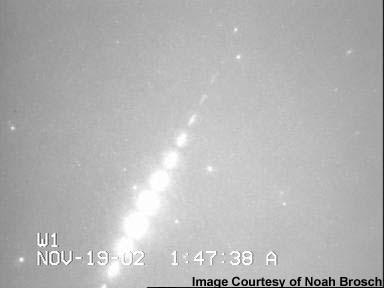The Leonid Meteor Shower Explained in 10 Facts
Each year around Nov. 17-18 the Leonid meteor shower peaks, offering up several shooting stars an hour. In some years there are dramatic bursts in which many meteors rain down every minute. The 2019 Leonid meteor shower will peak overnight Nov. 17-18.
Learn what's behind this fickle show with these fun facts here!
If you capture an amazing photo or video of the 2019 Leonid meteor shower and you'd like to share it with us and our partners for a story or image gallery, send images and comments in spacephotos@space.com.
Editor's note: This updated story was originally posted in November 2010.
Leonids are ancient history
Most of the shooting stars in the annual Leonid meteor shower are the result of tiny bits of material, the size of sand grains or peas, blown off a comet and wafting through space for centuries.
The Leonids are spawned by the comet Tempel-Tuttle. Every 33 years, it rounds the Sun and then goes back to the outer solar system. On each passage across Earth's orbit, Tempel-Tuttle lays down another trail of debris, each in a slightly different location than previous trails.
Over time, the debris trails spread out. Each year, Earth passes through different streams, and different parts of the streams, creating bursts of activity and slack periods in the nights surrounding the event's peak.
Breaking space news, the latest updates on rocket launches, skywatching events and more!
Next: Are the Leonids space trash?
Not a piece of space debris
Hey, wait a minute! I read … Yes, I know. We all conveniently think of meteors as bits of space debris, but it’s a white lie – one we'll keep committing for this fact. For the record, these bits of space debris are properly termed meteoroids.
When a meteoroid enters the atmosphere, the light phenomenon that results is a meteor, according to the American Meteor Society. So another way, a shooting star is a meteor phenomenon, not a chunk of something. That also means shooting stars aren't actually stars, of course, but I refuse to give up that term, too.
And just to finish this fruitless but mildly interesting discussion of shooting star jargon (quickly, please, so we can move on to the next fact): A meteorite is "a natural object of extraterrestrial origin (meteoroid) that survives passage through the atmosphere and hits the ground. Kids love this one: What do you call it if it misses the ground? A meteorwrong, of course.
Next: Do they reach Earth?
Leonids don't hit the ground
The heat created by a meteor (or meteoroid, if you prefer) vaporizes most of them high in the air.
Even larger space rocks, up to basketball size, typically burn up and don’t survive to the ground, though a handful -- those made of dense material -- do. However, comet material -- the stuff of the Leonids -- is "fluffy," astronomers say. It fragments and disintegrates easily.
And anyway, amongst the Leonids there are no basketballs. We’re talking sand grains mixed in with a few marbles. All fluffy.
Most meteors start lighting up until about 60 miles high (100 kilometers). Leonids, for reasons you'll soon learn, move more quickly and generate the beginnings of their demise more quickly. Leonids have been spotted turning on the juice above 87 miles (140 kilometers), where the air is really thin. A Leonid doesn’t stand a chance of reaching the surface, no matter what you call it.
Next: What causes their shine?
Leonids don't burn up due to friction
The myth that meteors shine because they rub against air molecules can be found in many news stories and reference articles about the Leonids and meteors in general. In fact, a meteor moves so fast that the air in front of it is compressed and heated by a phenomenon called ram pressure.
It’s the same thing that warms a hand-held pump when you work it to fill a bike tire. The heated air, in turn, scorches the meteor. Temperatures can exceed 3,000 degrees Fahrenheit (1,650 Celsius).
Next: You can hear the Leonids!
You can listen to the Leonids
Meteors leave behind a trail of ionized gas. Sometimes, the signal from a distant FM radio station or TV station will bounce off this trail, overcoming the Earth’s curvature, clouds and city lights and coming in loud and clear, if you know where to tune in. Instructions for listening to meteors are here.
On rare occasions, large meteors reportedly generate loud whistling or buzzing sounds that arrive to "earwitnesses" before they see the glowing fireballs in the sky. Sound can’t travel faster than light, but scientists are perplexed as to what’s going on.
Next: They can hit the moon...
Leonids strike the Moon, too!
Since the Moon ambles through the same region of space as planet Earth, it too is showered by small particles every November. However, there’s a difference: The Moon has no atmosphere to gobble up the grains. So the tiny bits of comet debris slam into the surface and explode.
Seismic recorders left on the Moon in the Apollo era recorded these Leonid strikes in the 1970s, and scientists first confirmed they occurred with visual observations during the 1999 Leonid meteor shower. In 2001, three separate skywatchers saw one of these lunar Leonids, using telescopes and looking for such events. They observed a brief flash of light equal in brightness to a dim star that would be visible to the naked eye under reasonably dark skies.
But how can a particle no larger than a marble and weighing only a few ounces create light visible from 238,900 miles (384,402 kilometers) away? Scientists have figured this out in recent years: Leonids travel so fast relative to the Earth and Moon – we'll discuss this power in a moment –that the impact per unit of mass is 10,000 times greater than dynamite. Moon dust for a few yards around the impact area is vaporized.
Next: The Leonids used to spark fear...
Leonids once thought to herald world's end
The Leonids typically produce a shooting star every few minutes during peak hours. Interesting, sure, but imagine what people must’ve thought in 1833, back before they even knew why the Leonids were happening.
For several hours over the United States that year thousands and thousands of meteors at a time rained down. That’s more shooting stars in few minutes than you’ll probably see in your whole life. The display was so bright it woke people up!
And, as you might guess, here’s what some of them thought: The world was going to end.
Next: What's up with their parent comet?
Comet Tempel-Tuttle keeps getting lost
When a comet takes 33 years to go around the Sun (compared to one year for Earth) it goes way out there and tends to get lost.
Comet Tempel-Tuttle, responsible for the Leonids, gets lost a lot. It also gets found now and then. Tempel-Tuttle was "discovered" by William Tempel in late 1865 and independently by Horace Tuttle in early 1866. Astronomers then figured out it had been observed in 1366 and 1699, too. An orbit was calculated, and they determined that the comet was connected to the annual Leonid meteor shower.
Nobody saw Tempel-Tuttle again until 1965, however. Then on March 4, 1997, armed with great orbital data, Karen Meech, Olivier Hainaut and James Bauer at the University of Hawaii "recovered" the comet yet again. Tempel-Tuttle will next return to the inner solar system in the year 2031.
Next: They are super powerful...
The power of the Leonids
Unlike many meteoroids that Earth encounters, the stuff of the Leonids is orbiting the Sun in the opposite direction as Earth. So it strikes Earth's upper atmosphere at a higher relative speed, more than 160,000 mph (72 kilometers per second).
A typical bullet from a rifle, moving at what seems like blinding speed, creeps along by comparison at just 2,240 mph (1,000 meters per second). The faintest meteor that becomes visible to the average viewer on Earth is typically about 0.6 millimeters across, less than one-tenth of an inch or about the size of a sand grain. The energy it produces could light a 100-watt light bulb for about 2.5 seconds.
Bright fireballs, for which the Leonids are known, can be generated by something the size of a marble, about 9 millimeters in diameter. The power it creates exceeds 1 million joules, or about the same punch as a small car moving at 60 mph.
Next: They're cosmic time capsules...
Leonids are time capsules, and maybe more
As you scan for Leonids, consider what you’re looking for: Tiny bits of primordial material generated in the cataclysm that was our solar system’s birth.
The Leonids are bits of comet debris, and scientists think comets formed along with the solar system’s generation, some 4.6 billion years ago, when the Sun condensed out of a cloud of hydrogen, helium and some dust. Tempel-Tuttle built itself out of some leftovers and has been looping around the Sun ever since, presumably, and its heart is pristine. Until corrupted on each pass by solar radiation that boils some of the comet into space.
The streaks of light you’ll see as these meteoroids strike the atmosphere probably represent the best glimpse you’ll ever have at the brimstone that ruled the solar system in the early days, before the planets had swept most of the leftovers up. Back then, stuff small and large hit Earth all the time. I say probably see because there are grander examples of this housecleaning to come: comets like Tempel-Tuttle do strike Earth now and then, and always will. That’s an event you don’t want to witness. And you probably won’t have to.
No comets (or asteroids) are known to be on collision courses with Earth right now. Odds are a big one won’t hit for a long, long time. Meanwhile, the ephemeral Leonids (or any meteors) are prized targets of scientific study, and scientists have used airplanes to examine a few at pretty close range in recent years.
What did they find?
Nothing less than the seeds of life, chemical precursors to biological activity that might long ago have survived inside a comet during a plunge into Earth’s initially barren womb. Yes, you may be related, in a distant way, to the streaks of light that grace the early morning sky each November.


Rob has been producing internet content since the mid-1990s. He was a writer, editor and Director of Site Operations at Space.com starting in 1999. He served as Managing Editor of LiveScience since its launch in 2004. He then oversaw news operations for the Space.com's then-parent company TechMediaNetwork's growing suite of technology, science and business news sites. Prior to joining the company, Rob was an editor at The Star-Ledger in New Jersey. He has a journalism degree from Humboldt State University in California, is an author and also writes for Medium.

